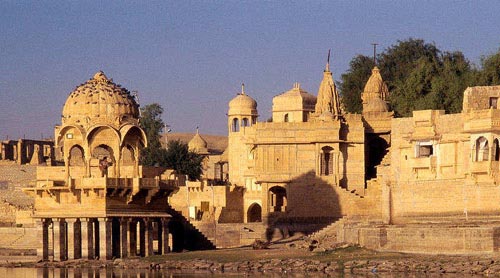Jaisalmer Fort

Information on Jaisalmer Fort (Jaisalmer, Rajasthan) - History & Architecture
Jaisalmer Fort is located on the foot hills of Trikuta, in Jaislamer Disrtict of Rajasthan State in India. This is the world's ever built largest fortification on the hills. It is a unique identity of the Rajasthan Desert, which have country border front with Pakistan on the western part of India. Jaisalmer is a national and international tourist destination. It can be reached out from the nearest junctions in India, like from Udaipur City its only 314 miles. From Ahmadabad it is about 333 miles. Jaipur city is 354 miles away. From its national capital New Delhi it is a distance about 484 miles and from Mumbai the distance is 685 miles. Jaislamer is well connected with state and national highways. It has railway station on major link lines on broad gauge. Jaisalmer civil aerodrome has daily schedule to Delhi, Mumbai, Ahmadabad, Hyderabad, Udaipur and Jaipur.
Jaisalmer Fort Architecture
Jaisalmer Fort is built on Rajput architecture of the early 12th Century AD. It is a dynamics structure in the desert land of Rajasthan. It is built with Yellow and red sandstones. This fort is a strong fortification surrounded by three major walls, which give its maximum protection from local and foreign invasion. It is a large fort designed in a rectangular pattern. It has many cylindrical wall extensions, mainly erected for garrison purposes. In side there are large floors for storage. Uncountable rooms are there to cater various needs by its occupants. Its walls are primarily built on yellow stones and it reflects a golden color in the sun light in the Thar Desert. On the inside, the fort is constructed on red sandstones. It has unique designs and pattern of craftsman works on its huge gates, windows, doors and pillars. This is the only desert fortification of its kind, unmatched any were in the world.
Jaisalmer Fort History
Jaisalmer Fort is also known as Sonar Killa, which means the Golden Fort. It shines glitters like gold in the day time. This fort is of greater importance in trade history in India. This was the Silk Route to Persia, Arab and African countries. Most of the traders passed by this fort and was a collection and exchange centre of goods and taxes. This fort was built by Bhati Rajput clans named Rawal Jaisal in the year 1156 AD. This fort was attacked and occupied by Alauddin Khilji in the 13th century AD and was in his control for a decade. During his attack many women's were forced to self immolate for the reason for not to captured by the enemies. The Mughals also tried it best to conquer this forts many times. This fort is under UNESCO site and maintained by world monument funds and the archeological department of Rajasthan. Millions of rupees were spent on its renovation works and it's now a pride of Thar Desert.
Jaisalmer Fort Tourism Importance
Jaisalmer Fort is a heritage site in Rajasthan. Tourists come here to see this hill fortification marvel. This is a protected monument by UNESCO as world heritage site. Many foreign tourists come here to see this heritage monument lying in desert land. To get a glimpse of this immense desert fortification, it is advisable to come in the autumn and winter seasons prevailing in India. Since this is a desert. The temperatures are above 40 degree Celsius. Best time to visit is from August to February of a calendar year. For accommodation there are heritage hotels and budget hotels. Locally there are many tour operators to ply the needs of tourists. Languages spoken here are Rajasthini, Sanskrit and Hindi. English is manageable everywhere here. The fort surroundings are with lots of desert adventures like camel safaris and air balloon aerial viewing.
- Andaman Nicobar Monuments
- Andhra Pradesh Monuments
- Assam Monuments
- Bihar Monuments
- Chhattisgarh Monuments
- New Delhi Monuments
- Goa Monuments
- Gujarat Monuments
- Haryana Monuments
- Himachal Pradesh Monuments
- Jammu and Kashmir Monuments
- Karnataka Monuments
- Kerala Monuments
- Madhya Pradesh Monuments
- Maharashtra Monuments
- Odisha Monuments
- Punjab Monuments
- Rajasthan Monuments
- Tamil Nadu Monuments
- Telangana Monuments
- Uttar Pradesh Monuments
- West Bengal Monuments